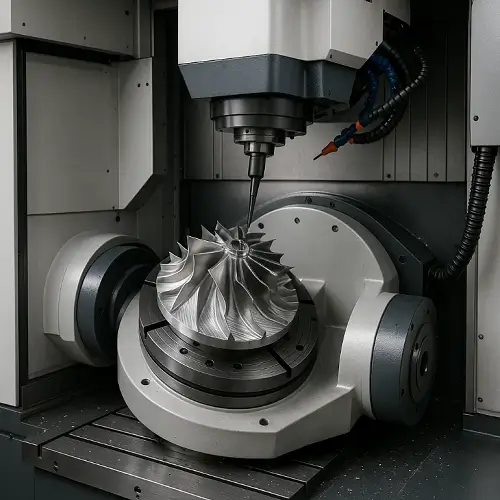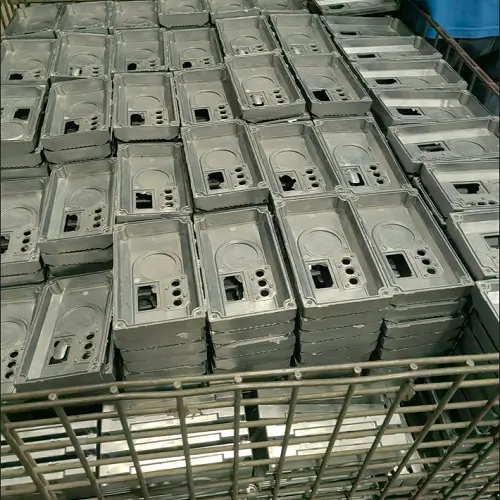Computer Numerical Control (CNC) machines emerged in the 1950s, initially developed for aerospace and defense manufacturing to achieve levels of precision and repeatability that manual machining could not match. Early NC (Numerical Control) systems relied on punched tape, but the arrival of microprocessors in the 1970s transformed them into fully programmable CNC systems.
Today, CNC machines are used across nearly every manufacturing sector, from automotive to medical devices, delivering consistent accuracy, high productivity, and the ability to work with complex geometries.
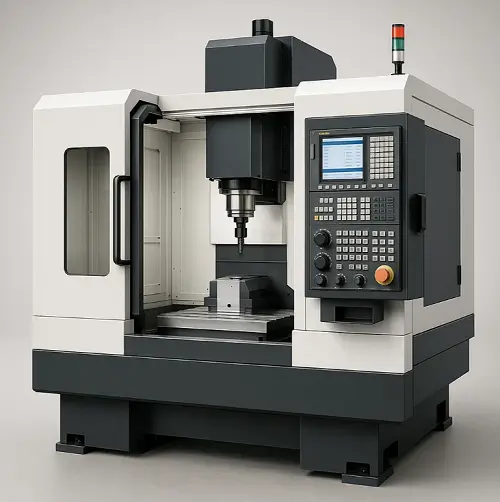
What Is a CNC Machine
A CNC machine is a manufacturing system where tool movement, spindle speed, and workpiece positioning are controlled by computer-generated code (G-code). This automation eliminates most manual adjustments, ensuring consistent quality from the first part to the thousandth.
Core Elements of a CNC Machine:
-
Controller: Processes G-code and sends precise movement commands.
-
Drive and Servo System: Converts commands into motion along multiple axes.
-
Machine Bed and Frame: Provides stability and reduces vibration.
-
Tooling and Spindle Assembly: Holds and changes tools for different operations.
-
Feedback Sensors: Maintain accuracy by monitoring position and speed.
CNC machines can work with metals, plastics, composites, wood, ceramics, and more—making them essential in industries requiring tight tolerances and complex part geometries.
Mainstream Types of CNC Machines
1. CNC Milling Machine
Removes material using rotating cutting tools. Available as 3 axis, 4 axis, and 5 axis CNC machines, with higher-axis models enabling complex surface machining and reduced setups. Widely used in aerospace, mold-making, and precision engineering.
2. CNC Lathe / CNC Turning Machine
Shapes rotating workpieces into cylindrical or conical parts. Common types include:
-
Horizontal CNC Lathe – Standard for shafts and large cylindrical parts.
-
Vertical CNC Lathe – Suitable for heavy or large-diameter workpieces.
-
Swiss-Type CNC Lathe – High precision for small, intricate components such as medical implants.
3. CNC Machining Center
Combines milling, drilling, and tapping in one system, often equipped with an automatic tool changer. Used in high-volume production for parts requiring multiple operations.
4. CNC Router Machine
Optimized for softer materials such as wood, plastics, and aluminum sheets. Common in furniture making, signage, and composite panel cutting.
5. CNC Plasma Cutting Machine
Cuts conductive metals using a high-velocity plasma arc. Favored in shipbuilding, automotive repair, and structural steel fabrication.
6. CNC Laser Cutting Machine
Uses a focused laser beam for high-precision cutting of metals, plastics, and composites. Popular in electronics, jewelry, and custom metalwork.
7. CNC Drilling Machine
Designed for drilling holes with high positional accuracy, used in automotive, aerospace assembly, and PCB manufacturing.
8. CNC Grinding Machine
Employs abrasive wheels to achieve extremely fine finishes and precise dimensions. Used in bearing production, tool sharpening, and precision surface finishing.
9. CNC Boring Machine
Enlarges pre-drilled holes to precise dimensions. Essential for engine blocks, heavy equipment components, and large industrial parts.
10. CNC EDM Machine (Electrical Discharge Machining)
Removes material using electrical sparks. Variants include Die-Sinking EDM and Wire Cut EDM, ideal for hard metals and intricate cavities.
11. CNC Waterjet Cutting Machine
Uses high-pressure water, sometimes mixed with abrasives, to cut metals, stone, glass, and composites without heat distortion.
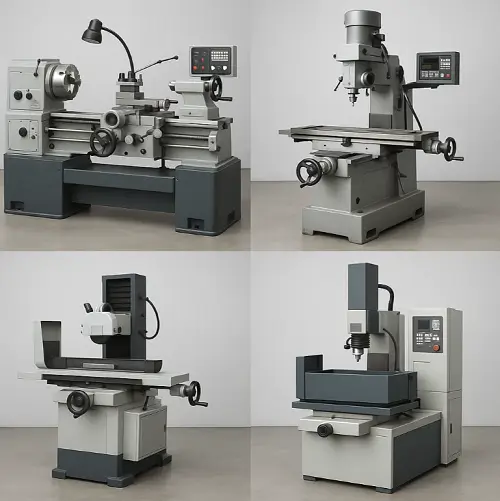
CNC Machine Technical Comparison
| CNC Machine Type | Relative Cost Level | Precision Level | Material Range | Common Applications |
|---|---|---|---|---|
| 3 Axis CNC Milling Machine | Medium | High | Metals, plastics, composites | General machining, prototyping |
| 5 Axis CNC Milling Machine | High | Very High | Metals, ceramics, composites | Aerospace, medical parts |
| Horizontal CNC Lathe | Medium | High | Metals, plastics | Shafts, bushings, threaded parts |
| Vertical CNC Lathe | High | High | Large metal parts | Heavy industry, automotive |
| Swiss-Type CNC Lathe | High | Very High | Small metal components | Medical, watchmaking |
| CNC Machining Center | High | High | Metals, plastics, composites | Multi-operation production |
| CNC Router Machine | Low to Medium | Medium | Wood, plastics, aluminum | Furniture, signage |
| CNC Plasma Cutting Machine | Medium | Medium | Conductive metals | Fabrication, repair |
| CNC Laser Cutting Machine | High | Very High | Metals, plastics, composites | Electronics, jewelry |
| CNC Drilling Machine | Low to Medium | High | Metals, composites | Hole drilling, PCB |
| CNC Grinding Machine | High | Very High | Hardened metals | Bearings, tools |
| CNC Boring Machine | High | High | Large metal parts | Engine blocks, heavy machinery |
| CNC EDM Machine | High | Very High | Hardened metals | Molds, dies |
| CNC Waterjet Cutting Machine | High | High | Metals, stone, glass, composites | Architectural, aerospace |
Selection Criteria for CNC Machines
Choosing the right CNC machine requires evaluating a combination of technical, operational, and economic factors. The decision directly impacts production efficiency, part quality, and long-term operating costs.
1. Material Type and Machinability
Different CNC machines are optimized for different materials. For example, CNC routers are ideal for wood, plastics, and light aluminum, while CNC grinding machines and EDM machines handle hardened steels and superalloys.
2. Part Geometry and Complexity
High-complexity parts with multi-sided features often benefit from a 5 axis CNC milling machine or a Swiss-type CNC lathe to minimize setups and maintain precision. Simple 2D profiles may be produced more cost-effectively on a CNC laser or waterjet cutting machine.
3. Tolerance and Surface Finish Requirements
Applications requiring ±0.005 mm tolerances or ultra-smooth finishes—such as medical implants, precision molds, or aerospace components—demand machines like CNC grinders, EDM, or advanced milling centers.
4. Production Volume and Cycle Time
For high-volume production, CNC machiningcenters with automatic tool changers and pallet systems offer reduced cycle times. For prototyping or small batches, flexible setups on 3 axis or 4 axis machines may be more cost-effective.
5. Budget and Operational Costs
Beyond initial investment, consider tooling costs, energy consumption, maintenance requirements, and operator training. The “right” CNC machine is one that balances these factors with expected return on investment.
By aligning machine capabilities with project requirements, manufacturers can achieve higher efficiency, lower waste, and superior quality in their CNC machining operations.
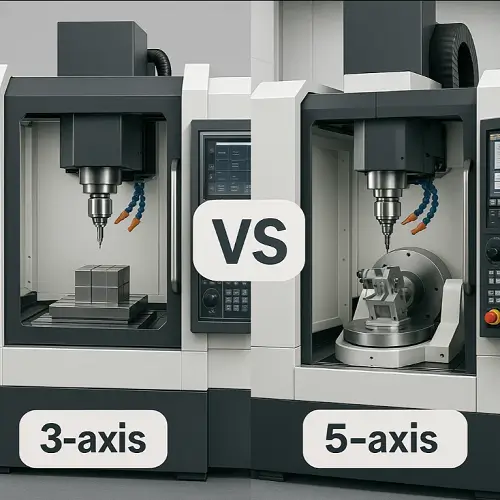
FAQ – Covering Common CNC Machine Questions
Q1: Which CNC machine is best for small business use?
CNC router machines and entry-level 3 axis milling machines are cost-effective choices for woodworking, light metal cutting, and prototyping.
Q2: What is the difference between a CNC lathe and a CNC milling machine?
A CNC lathe rotates the workpiece, while a CNC milling machine rotates the cutting tool. Lathes excel at cylindrical parts; milling machines handle complex shapes.
Q3: What are the advantages of a 5 axis CNC machine?
It allows machining of complex geometries in fewer setups, improving precision and reducing lead time.
Q4: Which CNC machine offers the highest precision?
Swiss-type CNC lathes, CNC grinding machines, and 5 axis CNC milling machines rank among the highest in precision.
Q5: Is CNC waterjet cutting suitable for metals?
Yes, waterjets can cut metals without generating heat, making them suitable for heat-sensitive materials.
Conclusion
CNC machines encompass a wide spectrum—from cost-efficient routers to ultra-precise 5 axis machining centers and grinding systems. Selecting the right machine requires evaluating material type, complexity, tolerances, and production goals.
JeekRapid delivers CNC machining solutions using all major CNC machine types, serving industries from prototyping to high-volume production. Upload your CAD files today for a detailed, no-obligation CNC machine cost analysis.

